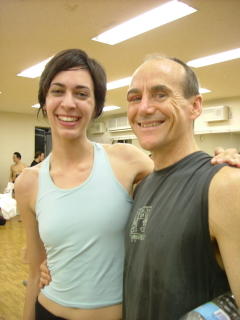
 Last night, from 7-9:30 pm, I joined 40+ other yogis & yoginis at a studio in Shinjuku to learn about Ashtanga yoga with David Swenson. The theme of last night's class was "The Physics of Flight" and we focused on the five ingredients necessary for having an Ashtanga practice: breath, vinyasa (flow), drishti (focus), bandha (body valves) & asana (postures). Whew, when I write it out like that there's a lot going on in the body when you do yoga.
Last night, from 7-9:30 pm, I joined 40+ other yogis & yoginis at a studio in Shinjuku to learn about Ashtanga yoga with David Swenson. The theme of last night's class was "The Physics of Flight" and we focused on the five ingredients necessary for having an Ashtanga practice: breath, vinyasa (flow), drishti (focus), bandha (body valves) & asana (postures). Whew, when I write it out like that there's a lot going on in the body when you do yoga.For the purpose of this post, let me just focus on one of these 'ingredients,' the breath. The breath is the thread that holds all 5 of the ingredients together. It's the one thing that, if we don't have it, we don't have a yoga practice at all. Last night David said, "the minds is more difficult to control than the wind." And from the Upanishads (sacred yoga texts), "he who has control over his breath has control over his mind." What does this mean for us when we approach the mat? Do we even need yoga in order to reign in the breath/mind? Yoga is a tool for learning to control the breath, and it takes time but eventually you can learn to inhale and exhale with the movement. That's where the idea of 'flight' comes into play. The breath allows you to glide, or flow, or fly, easily between poses.
Clearly there are other ways to flow/fly in life. You can paraglide, skateboard or race cars. Yoga is an accessible, safe way to fly. And all you need, really, is your body. And to do that one thing you've done a handful of times while reading this post: breathe.
Gwen
Yoga Garden


